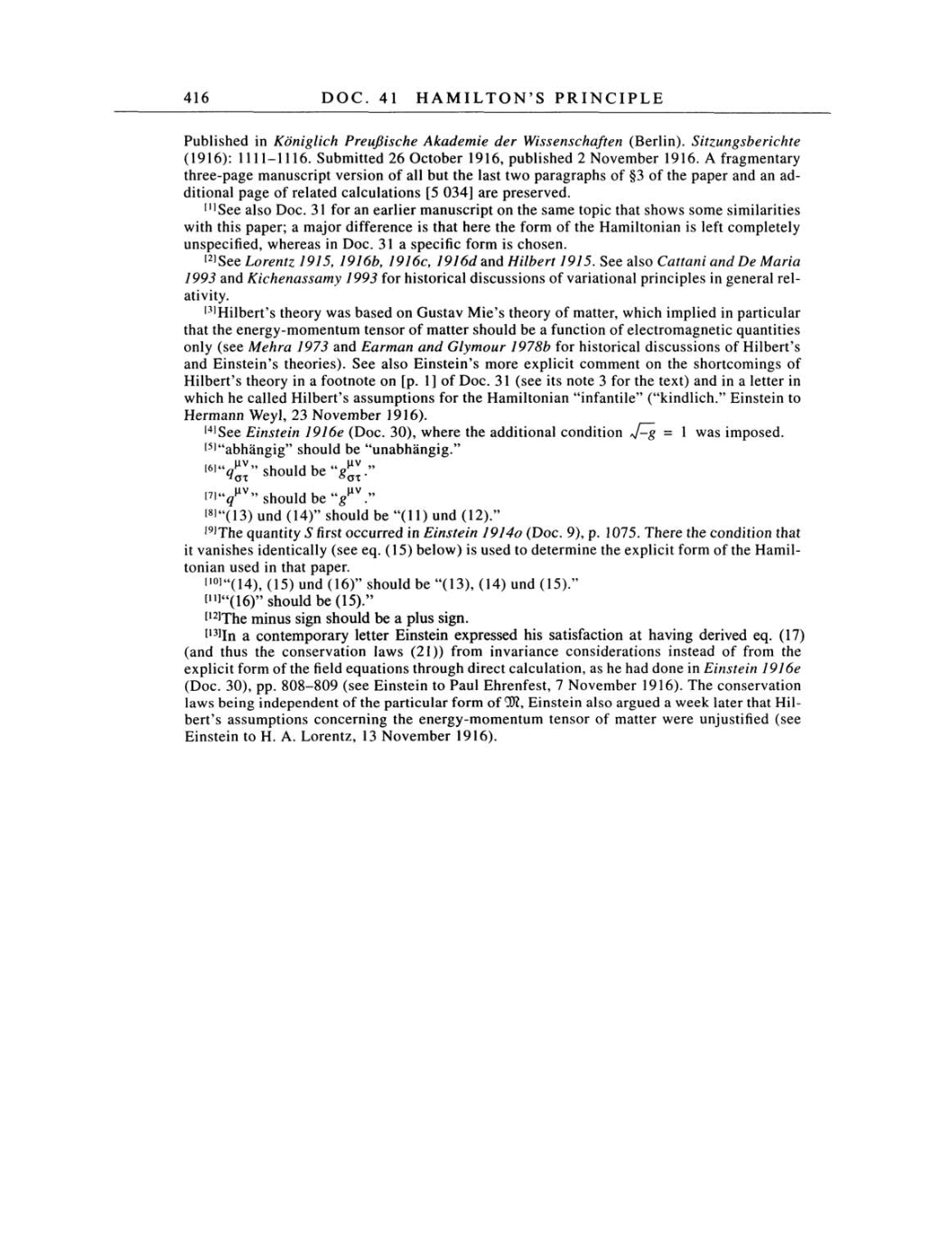416
DOC.
41
HAMILTON'S
PRINCIPLE
Published
in
Königlich Preußische
Akademie
der
Wissenschaften (Berlin). Sitzungsberichte
(1916):
1111-1116. Submitted
26
October
1916, published
2
November
1916. A
fragmentary
three-page manuscript
version of
all
but the last
two paragraphs
of
§3
of the
paper
and
an
ad-
ditional
page
of related calculations
[5
034]
are
preserved.
[1]See
also Doc.
31
for
an
earlier
manuscript
on
the
same
topic
that shows
some
similarities
with this
paper;
a
major
difference
is
that here the form
of the
Hamiltonian
is
left
completely
unspecified,
whereas
in
Doc.
31
a
specific
form
is
chosen.
[2]See
Lorentz
1915,
1916b, 1916c,
1916d
and
Hilbert
1915. See
also Cattani and
De
Maria
1993 and Kichenassamy 1993
for historical discussions of variational
principles
in
general
rel-
ativity.
[3]Hilbert's
theory
was
based
on
Gustav Mie's
theory
of
matter,
which
implied
in
particular
that the
energy-momentum
tensor
of
matter
should
be
a
function of
electromagnetic quantities
only
(see
Mehra
1973 and
Earman and
Glymour
1978b for historical discussions of Hilbert's
and
Einstein's
theories).
See also Einstein's
more
explicit comment
on
the
shortcomings
of
Hilbert's
theory
in
a
footnote
on [p. 1]
of Doc.
31
(see its
note 3
for the
text) and in
a
letter
in
which
he
called Hilbert's
assumptions
for the Hamiltonian "infantile"
("kindlich."
Einstein
to
Hermann
Weyl,
23
November
1916).
[4]See
Einstein 1916e
(Doc. 30),
where the additional condition
V-g
=
1
was
imposed.
[5]"abhängig"
should
be
"unabhängig."
[6]"quvoT"
should be
"guvoT."
[7]"quv"
should
be "guv."
[8]"(13)
und
(14)"
should be
"(11)
und
(12)."
[9]The
quantity
S first
occurred
in
Einstein 1914o
(Doc.
9),
p.
1075.
There the condition that
it
vanishes
identically
(see
eq.
(15) below) is
used
to
determine the
explicit
form of
the
Hamil-
tonian used
in
that
paper.
[10]"(14),
(15)
und
(16)"
should be
"(13), (14)
und
(15)."
[11]"(16)"
should
be (15)."
[12]The
minus
sign
should
be
a
plus sign.
[13]In
a
contemporary
letter Einstein
expressed
his satisfaction
at having
derived
eq.
(17)
(and
thus
the
conservation laws
(21))
from invariance considerations instead of from
the
explicit
form of
the field
equations through
direct
calculation,
as
he had
done
in
Einstein 1916e
(Doc.
30), pp.
808-809
(see
Einstein
to
Paul
Ehrenfest,
7
November
1916).
The conservation
laws
being independent
of the
particular
form of
9)?,
Einstein also
argued
a
week later that Hil-
bert's
assumptions concerning
the
energy-momentum tensor
of
matter
were
unjustified
(see
Einstein
to
H. A. Lorentz,
13
November
1916).
